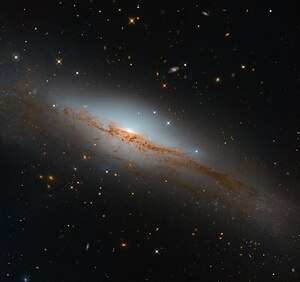NGC 3749
| Galaxie NGC 3749 | |
|---|---|
(c) ESA/Hubble, CC BY 4.0 | |
| Die Galaxie NGC 3749, aufgenommen mithilfe des Hubble-Weltraumteleskops | |
| AladinLite | |
| Sternbild | Zentaur |
| Position Äquinoktium: J2000.0, Epoche: J2000.0 | |
| Rektaszension | 11h 35m 53,2s[1] |
| Deklination | -37° 59′ 50″ [1] |
| Erscheinungsbild | |
| Morphologischer Typ | SA(s)a pec / sp / HII [1] |
| Helligkeit (visuell) | 12,9 mag [2] |
| Helligkeit (B-Band) | 13,8 mag [2] |
| Winkelausdehnung | 4,2′ × 1,2′ [2] |
| Positionswinkel | 107° [2] |
| Flächenhelligkeit | 14,5 mag/arcmin² [2] |
| Physikalische Daten | |
| Rotverschiebung | 0.009013 ±0.000043 [1] |
| Radialgeschwindigkeit | 2702 ±13 km/s [1] |
| Hubbledistanz vrad / H0 | (112 ± 8) · 106 Lj (34,3 ± 2,4) Mpc [1] |
| Geschichte | |
| Entdeckung | John Herschel |
| Entdeckungsdatum | 21. April 1835 |
| Katalogbezeichnungen | |
| NGC 3749 • PGC 35861 • ESO 320-G008 • MCG -06-26-002 • IRAS 11333-3743 • 2MASX J11355320-3759503 • GC 2459 • h 3351 • AM 1133-374 • LDCE 0916 NED004 | |
NGC 3749 ist eine Spiralgalaxie vom Hubble-Typ Sa im Sternbild Zentaur, die im New General Catalogue verzeichnet ist. Sie ist schätzungsweise 112 Millionen Lichtjahre von der Milchstraße entfernt.
Das Objekt wurde von dem Astronomen John Herschel am 21. April 1835 mithilfe seines 18,7-Zoll-Spiegelteleskops entdeckt.[3]
Einzelnachweise
Auf dieser Seite verwendete Medien
(c) ESA/Hubble, CC BY 4.0
For this Picture of the Week, the NASA/ESA Hubble Space Telescope turned its powerful eye towards an emission line galaxy called NGC 3749.
When astronomers explore the contents and constituent parts of a galaxy somewhere in the Universe, they use various techniques and tools. One of these is to spread out the incoming light from that galaxy into a spectrum and explore its properties. This is done in much the same way as a glass prism spreads white light into its constituent wavelengths to create a rainbow. By hunting for specific signs of emission from various elements within a galaxy’s spectrum of light — so-called emission lines — or, conversely, the signs of absorption from other elements — so-called absorption lines — astronomers can start to deduce what might be happening within.
If a galaxy’s spectrum shows many absorption lines and few emission lines, this suggests that its star-forming material has been depleted and that its stars are mainly old, while the opposite suggests it might be bursting with star formation and energetic stellar newborns. This technique known as spectroscopy, can tell us about a galaxy’s type and composition, the density and temperature of any emitting gas, the star formation rate, or how massive the galaxy’s central black hole might be.
While not all galaxies display strong emission lines, NGC 3749 does! It lies over 135 million light-years away, and is moderately luminous. The galaxy has been used a “control” in studies of especially active and luminous galaxies — those with centres known as active galactic nuclei, which emit copious amounts of intense radiation. In comparison to these active cousins, NGC 3749 is classified as inactive, and has no known signs of nuclear activity.



